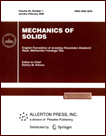 | | Mechanics of Solids
A Journal of Russian Academy of Sciences | | Founded
in January 1966
Issued 6 times a year
Print ISSN 0025-6544
Online ISSN 1934-7936 |
Archive of Issues
| Total articles in the database: | | 13362 |
| In Russian (Èçâ. ĐÀÍ. ̀̉̉): | | 8178
|
| In English (Mech. Solids): | | 5184 |
|
| << Previous article | Volume 60, Issue 4 / 2025 | Next article >> |
| N.K. Salikhova, D.S. Dudin, I.E. Keller, G.L. Permyakov, and D.N. Trushnikov, "Modelling the Evolution of Eigenstrains and Residual Stresses During Wall Deposition on a Substrate by Wire-Arc Surfacing," Mech. Solids. 60 (4), 2516-2530 (2025) |
| Year |
2025 |
Volume |
60 |
Number |
4 |
Pages |
2516-2530 |
| DOI |
10.1134/S0025654425601296 |
| Title |
Modelling the Evolution of Eigenstrains and Residual Stresses During Wall Deposition on a Substrate by Wire-Arc Surfacing |
| Author(s) |
N.K. Salikhova (Institute of Continuous Media Mechanics of UB RAS, Perm, 614018 Russia, salikhova@icmm.ru)
D.S. Dudin (Institute of Continuous Media Mechanics of UB RAS, Perm, 614018 Russia, dmitryovj@yandex.ru)
I.E. Keller (Institute of Continuous Media Mechanics of UB RAS, Perm, 614018 Russia, kie@icmm.ru)
G.L. Permyakov (Perm National Research Polytechnic University, Perm, 614990 Russia, gleb.permyakov@yandex.ru)
D.N. Trushnikov (Perm National Research Polytechnic University, Perm, 614990 Russia, trdimitr@yandex.ru) |
| Abstract |
The regularities of residual stress formation and distortion of the product shape occurring during wire-arc surfacing are studied. Therefore, the results of full-scale experiments carried out by Cranfield University are reproduced numerically. In the experiments, surfacing of wire material is carried out in 9, 10, and 18 layers on a fixed substrate along a reciprocating path at a speed of 10 mm/s, including interlayer roller burnishing with variable pressure. The numerical modelling includes several stages, during which the following uncoupled problems are sequentially solved: a) thermal – surfacing of 9 to 18 layers of wire material, b) thermal elastic-plastic – formation of eigenstrains and residual stresses due to air cooling of the deposited wall with non-uniform temperature distribution, c) thermal elastic-plastic – forging of a stressed workpiece with a pneumatic tool at elevated temperature (the stage may be omitted), and d) elastic-plastic – changes in the field of residual stresses and distortion of the structure after its release. The problem of thermal conductivity (a), as well as the problems of deformation (b), and (d) during surfacing of wire material are implemented in the Comsol Multiphisics software package, and the problem (c) is solved in the LS-DYNA software package. In addition, an “engineering” beam-rod structural model of the built-up wall is developed, which makes it possible to predict the wall distortions and the distribution of eigenstrains and residual stresses along its height, and verify the numerical calculation. This model represents the magnitude of longitudinal bending of the specimen during surfacing, but excessively takes into account the effect of roller burnishing. Even a single roller burnishing causes the bending of the structure in the opposite direction, while in the experiment it only straightens. |
| Keywords |
wire-arc surfacing, layer-by-layer forging, residual stresses, distortions, experiment, mathematical model |
| Received |
18 March 2025 | Revised |
26 May 2025 | Accepted |
28 May 2025 |
| Link to Fulltext |
|
| << Previous article | Volume 60, Issue 4 / 2025 | Next article >> |
|
 If you find a misprint on a webpage, please help us correct it promptly - just highlight and press Ctrl+Enter If you find a misprint on a webpage, please help us correct it promptly - just highlight and press Ctrl+Enter
|
|

 Russian
Russian  English
English